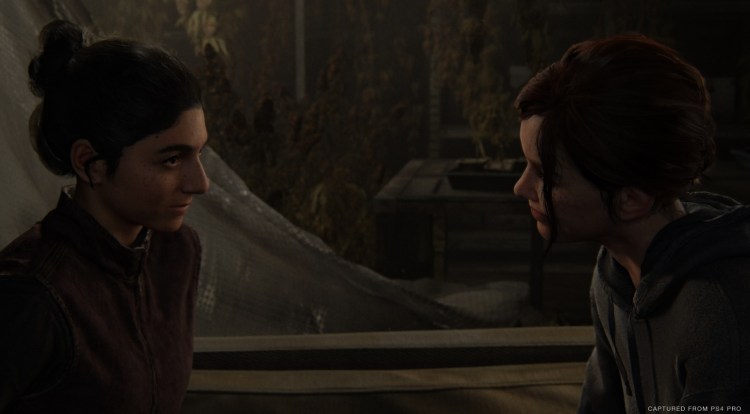The Last of Us Part II is finally coming to us on February 21, 2020. And I couldn’t be more excited to play this sequel to the 2013 title, which was my favorite game of all time.
So you can imagine I was a bit jazzed to attend a preview event on Tuesday in Los Angeles, where Naughty Dog and Sony announced the game’s launch date, revealed a new trailer, and let us play two levels of the game — Jackson and Seattle — for a couple of hours. It looked remarkably good for a game that was running on the PlayStation 4 Pro, a system that will be replaced next year with the PS5.
After I played, my nerves were a bit frayed from the intensity. Still, I sat down with Newman to talk about the game without sounding too breathless. We touched on the thinking behind the sequel to my favorite game of all time. We talked about what Naughty Dog wanted to say with its sequel, how new gameplay elements like dogs that hunt you change the game, and the high stakes as you worry about whether someone you love is going to get killed in the game.
Here’s an edited transcript of our interview.
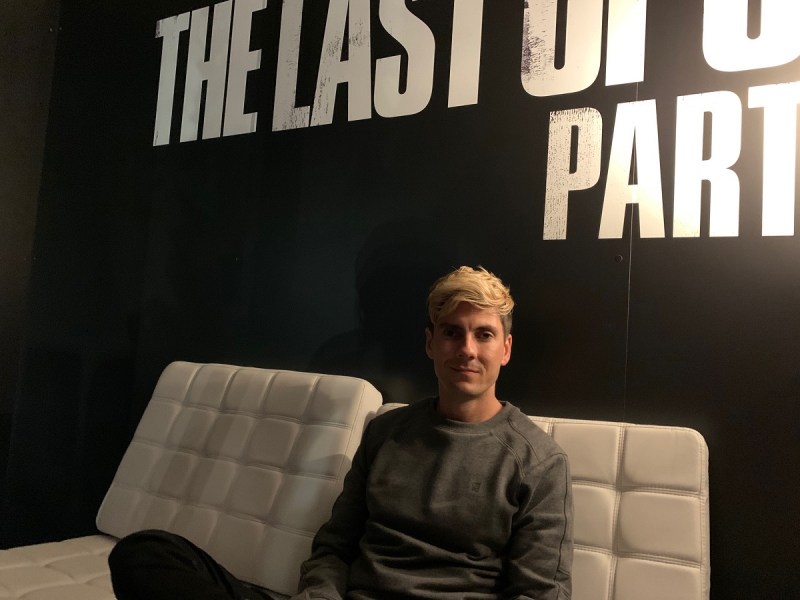
Above: Anthony Newman, co-director of The Last of Us Part II.
GamesBeat: What’s your role been on the project? Did you work on the last game?
Anthony Newman: I was a lead designer on Uncharted 4. Right after Uncharted 4 I started working on The Last of Us Part II, and midway through I was promoted to co-game director.
GamesBeat: It’s an interesting set of revelations today. What was the thinking behind what you decided to show?
Newman: This is actually kind of unusual for us as far as how we’ve paced things out. This is by far Naughty Dog’s most ambitious game. It’s the longest game we’ve ever made, and the deepest and most complicated. It’s not just in terms of overall length. The systems are way more intricate and complex.
We thought it was much better for people to experience that for themselves, rather than having us just talk about it or show a short trailer. We wanted to show a solid chunk of gameplay, seeing multiple contexts in the game. You see the snowy location, the overgrown suburbs of Seattle. You get multiple environments and multiple enemy types, both humans and infected, as well as our new dog enemies and some of our new infected classes. We thought all of that put together would make clear what kind of game this is.
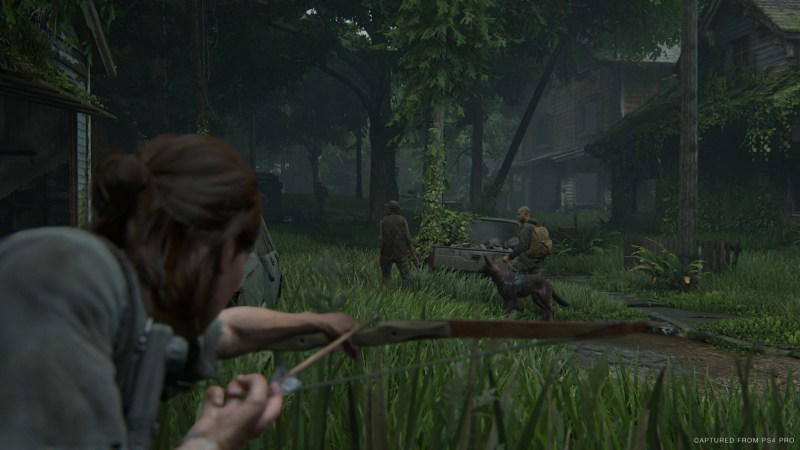
Above: You better take out that dog first in The Last of Us Part II.
GamesBeat: The dogs change the gameplay a lot. You go into the same kind of space, but now you have to really pay attention to how much you want to expose yourself.
Newman: Absolutely. Stealth has always been a core part of combat in Last of Us. We’re really excited about what dogs bring to the table, both mechanically and narratively. From a mechanical perspective, not only are they really fast, but they have this devastating melee attack, where they can pounce on you. They’re hard to track, moving quickly and low to the ground. By being able to sniff you and pick up your trail — you can’t play purely defensively by staying unseen, because eventually there’s a good chance that a dog will pick up your trail and you have to interact with them. It’s a great way of keeping players on their toes.
From a narrative perspective, it speaks to the themes we have in the game around how far you’re willing to go to exact vengeance on the people who’ve wronged you. It puts players in uncomfortable positions, having to fight against what are usually friendly animals. In the context of this world, they’re really deadly creatures that you have to deal with. That kind of reluctant, uncomfortable violence is a big part of The Last of Us.
GamesBeat: It’s still very intense.
Newman: I get excited about the combat challenge they create. One thing that’s cool is we have this system now where, whenever you’re knocked to the ground and you’re lying on your back — it’s called supine. Prone is lying on your stomach, supine is lying on your back. If you aim from that state, you can aim while lying down, or you can dodge roll out of it. It’s a fully featured state that you can be forced into if you’re shot, or when a dog pounces on you.
I’ve seen people here today get into situations where a dog pounces on them, they struggle with the dog, and then kick it off. Then they’re approached by another human enemy and they have this very cinematic moment of fighting from the ground. There’s a lot of cool, intense moments that come about.

Above: 30 years after the fungal outbreak, there are still rules to follow in The Last of Us Part II.
GamesBeat: The dogs also feel like they restore a lot of tension. Sometimes you’re trying to hide or stay defensive, but there’s still that feeling of being hunted.
Newman: Like I was saying before, it prevents you from doing what’s usually the simplest strategy in stealth games, which is just remaining unseen. In stealth games you need to worry about enemy vision or hearing, but now there’s this whole new sense of smell you have to be concerned about.
What’s great is that we’ve matched that new challenge with a bunch of new abilities for Ellie. She can now craft arrows, the first time you’ve been able to craft ammo for your weapons. There’s a cool crossover between the crafting system and the gunplay system. You can craft silencers for your gun, so you have a limited ability to make your shots suppressed. Now, even for stealth players, despite the dogs negating certain strategies, we’ve opened up new opportunities for gameplay.
GamesBeat: I kind of blew it in one area, the room where the runners are all gathered, about six of them. I went in there once, got killed, and then I tried to go in a second time and wasted all my ammo. If I’d just used one of those trap mines, they would have run right into it. I made it out at the very end of the level with nothing left but a bottle.
Newman: That’s great. Sometimes that’s all it takes, just a bottle.
GamesBeat: I had to do a lot of melee fighting. But you can create some interesting sets of circumstances to push people in different directions. I was just barely surviving, but if I’d had all that ammo there would have been a different feeling to the level.
Newman: That’s one thing that’s been a fun challenge to try and tackle in this game. We want to allow for a broad range of play styles and honor all of those play styles. One thing that’s interesting is if you play completely stealthy, and you just stealth kill everyone and use no ammo, you can get into an encounter and be overloaded. You just dump all your ammo on one encounter and potentially trivialize it. Or you have the reverse situation like you had, where you use up all the ammo early and then you don’t have it when it might be useful. It’s been a fun challenge to try to honor as many play styles as possible, as many circumstances the players can find themselves in.
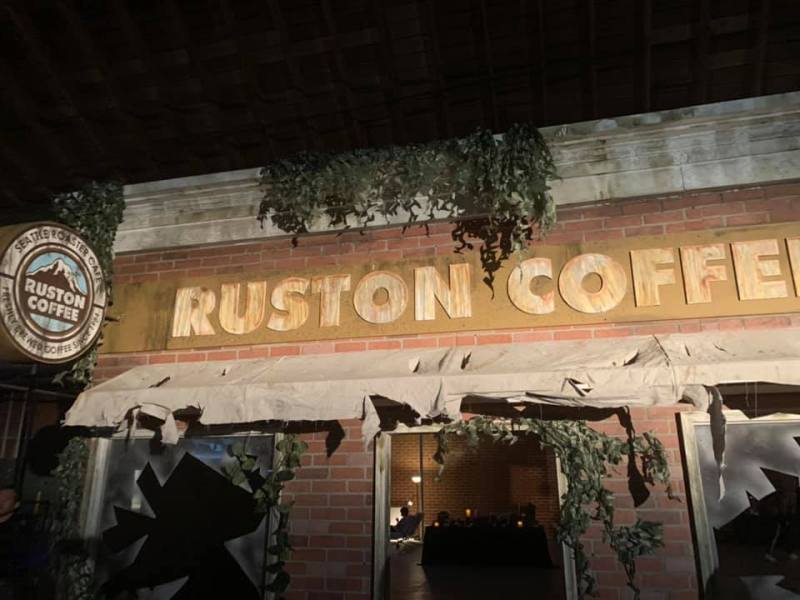
Above: Sony created a real-life rendering of the Ruston Coffee shop from The Last of Us Part II.
GamesBeat: As far as context, how much are you giving people? I didn’t really know that it was just one day later, after the kiss from the last scene, until somebody mentioned it. That was a rare moment, where we got a little bit of information about how much time has passed. Is there much else you’re giving as far as that kind of context, or do you find that people function fine without all of that? Even in the trailer, you didn’t reveal too much larger world context.
Newman: This is my first game in this role, and so I’ve been a lot more involved in the marketing than I have been before. One thing that I find really interesting is that when it comes down to it, the marketing phase of the game is as much a part of the story that we’re trying to tell with the main game as the main game itself. Every piece of information, the schedule that we follow to release that information, exactly what we’re showing, it’s all done very purposefully to give people just enough of a picture of the game to be intrigued, and have a general idea of what’s going on, but still be excited and surprised when they play the actual game. It’s like a prologue. We’re really careful about what we choose to show.
GamesBeat: Different parties, like the Fireflies, are they still part of this in some way? I read some things that mentioned them.
Newman: We’re not talking too much about the Fireflies. Really, the group that we were showing in the demo today is the WLF, the Washington Liberation Front. They’re almost a military-esque organization. They’re a militia, really. They’ve taken over the area of Seattle. Previously, at E3, we showed another group that we haven’t talked about in too much detail, but the Seraphi, a different group that’s also in Seattle. How those groups relate is a mystery that you’ll have to wait for in the game.
GamesBeat: Are there any other big hints in what we saw today about things that are very similar or very different from the previous game?
Newman: For me, the thing that most defines this game is that every single facet, from the technology to the mechanical game design to the narrative — I feel like every facet, we’re trying to take a quantum leap forward with this game. For example, in the first game, there was no dodge. It was a very simple melee system. When we added the dodge mechanic, we wanted to do it in a way that lived up to Naughty Dog animation quality.
In other games, when you dodge in different directions, maybe there are four different directions you can dodge in, four different animations. In The Last of Us Part II, it’s contextual to the direction that the enemy attacks from and the direction you move to. If an attack is coming vertically and you’re going to the left, it’ll play an animation where she leans to the left, just missing the attack that’s coming. If it’s a horizontal attack, she’ll duck to the right. There’s this pool of dodge animations.
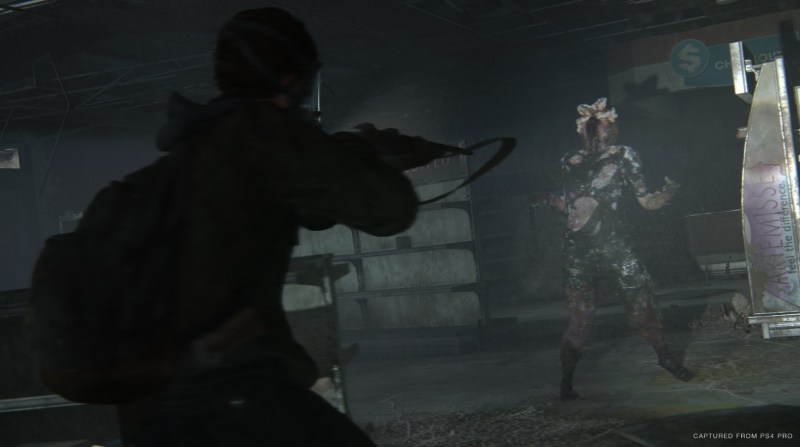
Above: Those Clickers are back in The Last of Us Part II.
In terms of the melee combat, we’ve added a whole new dimension to the gameplay. We’ve never been able to support one-on-one melee duels before, like you had with the guy you took the bow from, Boris. By adding a dodge button, we’re able to take that gameplay a new level, but also do it in this way that, visually, is unique to us. There’s a great deal of fidelity. That’s the thing I’m most excited about.
Another example, we have this new upgrade system where it allows you to express yourself creatively in the strategy that you want to pursue. We’ve had an upgrade system before, and it had some great aspects, but in some ways it was just stat boosts. You were just raising certain stats about yourself. We still have upgrades like that, but we also have stuff where you get entirely new abilities that are unlocked through the upgrade system, that you can choose to have or not have. For example, crafting the silencer item, that’s something you have to choose to pursue. You can do that at the expense of some other upgrade that might be important to you.
Some of these are quite game-changing. You can shorten the length of the stealth kill dramatically — something like a third of the length — which can make you much more efficient. You can increase your prone movement speed, so as you move through grass — sometimes I feel like a land shark, cruising around and taking people down. You can even get an upgrade where you create two smoke bombs for the price of one. You can alter the game’s economy in a way where you’re now leaning way heavier on a mechanic because you can craft more items per resource. That’s one way the gameplay is way more flexible.
I’ve had to play this demo about a million times, and it never gets boring, because there are so many new ways to approach each encounter, so many new upgrades to experiment with. There are lots of synergies to discover and experiment with.
GamesBeat: How did you get so much more visual improvement out of the same platform? You’re still on the PS4.
Newman: Honestly, I don’t have the technical expertise to really know about that. But it does look phenomenal. The vast majority of it isn’t just stuff that you get from raw power, just putting more polygons on screen. Most of the things that are really striking to look at are from new techniques, new things that aren’t necessarily — they’re more expensive, but it’s really the cleverness of the algorithm that makes them so cool.
A big one that I’m excited about is called motion matching. It’s this algorithm where — normally, in player navigation systems, the system that governs Ellie and the enemy NPCs moving around the space — normally you program it in such a way where, if you press forward, play the run forward animation. Press left, play this turn animation and then play the left run animation.
Motion matching, instead, has this huge bucket of animations. They mocapped someone running around a space, doing all these loops and turns, and chopped that animation into really small pieces. Based on your stick input and the speed you were going and the speed your about to move to, it pulls three or four animations from that pool and blends them together in just the right way to get the perfect motion from where you were going to get to.
I remember when they turned that on. I couldn’t believe it. It was this incredible next-gen leap. Again, it’s purely a technique. We didn’t need that much more hardware in order to run that. It was just the cleverness of the technique.
GamesBeat: I thought you were actually going to wait for the PS5 to come along.
Newman: Apparently not!
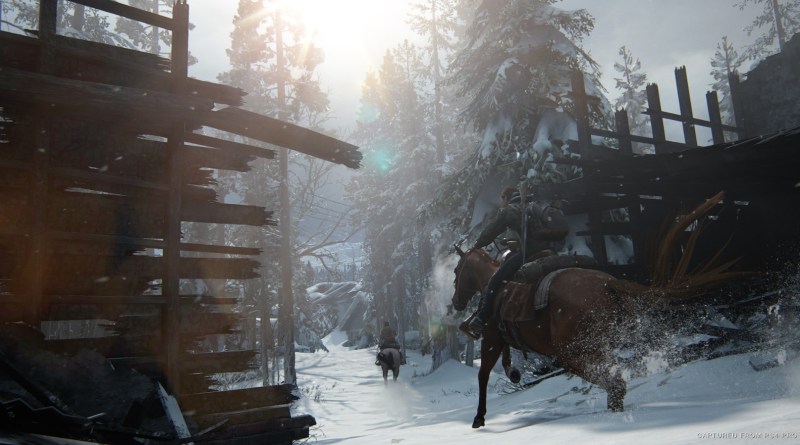
Above: On patrol in The Last of Us Part II.
GamesBeat: One thing I liked about the original game was that you care for this other person, but you’re also constantly worried that one of you is going to get into some serious trouble. It seems like that’s something you’re grabbing onto again. It’s a source of engagement, or tension, another way to make this a gripping story.
Newman: What we say a lot, or what we talk about a lot, is that our world is one with high stakes. Death can come swiftly and at any time for any of these characters. We do a lot of work making you care about them, showing that they’re vulnerable humans, building your empathy for them. The scene where Ellie and Dina are in the grow house — that, to me, reminds me a lot of situations I’ve been in, in high school or something, that kind of early romance. Those tentative first steps to falling in love with someone.
That’s a big part of why the way the violence is portrayed in the game is so gritty and so realistic. It makes it clear that the stakes are always very high. One way we achieve that is by making the enemy AI feel very human. That’s why we pursued creating names for all of our NPCs, so they could call each other by name and react in anguish when they see a friend die. That makes them feel like they’re intelligent and deadly, because they react in a way that human beings would react. That just raises the stakes. You’re dealing with humans who will do anything to survive. Those are the stakes in this world.
GamesBeat: And since this is a story about revenge, we know something bad has happened.
Newman: The event, yes. [chuckles]
GamesBeat: Is there anything else you’d like to cover?
Newman: The thing I really want people to understand about this game is that — as high as the expectations are for the sequel to such a highly-regarded game, I think that we’re going to go beyond those expectations. From the sound design to the AI to the environments to the level design, the breadth of the level design — we’re doing wide and vertical environments. You can see from the trailer that the breadth of places you go to, from the flooded city to these forests to all these different places — it really is far and away the most ambitious game we’ve ever made. I can’t wait for people to play it.
